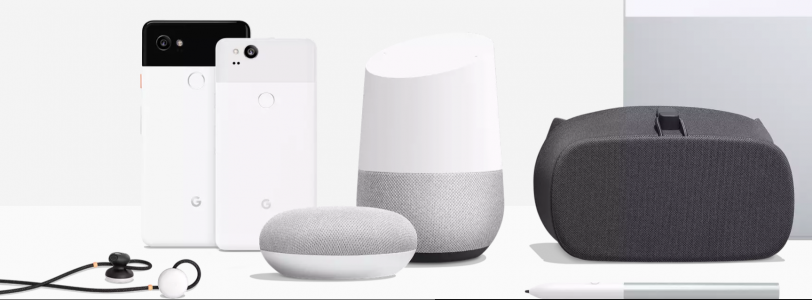If you have been a close follower of Google's hardware efforts across the years, you are probably aware that the search engine giant has treated the endeavour more as a hobby than a serious business strategy. Phone products like the Nexus line of phones were always in short supply and fraught with ordering issues. Their tablets, while mostly inexpensive, were never really well supported, with Android always struggling to get app support for larger screen sizes. And have you heard of the Nexus Q?
Indeed, I argue it wasn't until the first Chromecast, introduced in 2013 for a mere £30, that Google really had a hardware hit. The simplistic streaming dongle has proven to be a bit of a dark horse, and the hardware and accompanying software are now large parts of Google's strategy for conquering the home.
In 2016 Google showed they were starting to take a legitimate interest in hardware. This year, they're shouting it loudly!
Pixel 2 and Pixel 2 XL
Highly anticipated and thoroughly leaked, Google officially took the wrappers off their 2017 flagship phone hardware. The original Pixel and Pixel XL phones were well received (if you managed to order one) but were chided for their lack of waterproofing, stereo speakers and being just a little bit ugly.
Google has resolved some issues while introducing others with this years' lineup. The Pixel 2 will keep the same 5-inch screen size, while the larger XL has jumped from 5.5-inch to 6-inches, with a near edge-to-edge display. The bizarre glass panel on the back of the phones have been shrunk down, and the bezels on the larger of the two phones have also had a trim. Rather disappointingly, the smaller of the two phones retains the massive bezels of the previous.
Spec wise it's a pretty standard affair. The latest Snapdragon 835 processor, 4GB of RAM and a choice of 64GB or 128GB storage. Both phones have OLED displays - the smaller pixel has a 1080p screen resolution which the larger has a 2880 x 1440 display. The screen is always on, showing notifications and the time, as well as listening out for music and displaying the artist and song title on screen. Google has also borrowed some HTC tech trickery to make the phones squeezable to trigger certain function - a feature Google calls "Active Edge".
The camera was the focal point (!) of the Pixel lineup last year, and the same is true with the 2. Both phones have exactly the same camera sensor in them, and despite there being only the one sensor, Google are claiming they can still do all the portrait photography using software and something Google calls a "dual-pixel sensor", whereby every pixel is divided into two and allows for a depth map to be created. On paper it seems like they have things worked out, with DXO scoring the camera a record-breaking 98. Both have 12.2-megapixel rear cameras with optical image stabilization.
They also got rid of the headphone jack.
Google Home Mini and Max
Building off of the success of the Google Home, the Mini and the Max have been announced to further compliment your new Internet of Things lifestyle.
Starting with the Mini, it is essentially a direct response to the Amazon Echo Dot. Small and moderately inexpensive, it will serve as a great gateway into the world of Voice Assistants and home automation, or perhaps complement an existing set-up by allowing you to have a Home in another room. It costs £49 and does everything the current Google Home does.
The Max is, as the name suggests, a larger Google Home that is fully geared towards music. 20 times more powerful than the original Google Home, with two 4.5 inch woofers and dynamic sound calibration to ensure it sounds good wherever you put it, Google says it is the best sounding Home they've ever made. And so it should be. With a starting price of $399, the Max is going to be competing with Sonos speakers and Apple's upcoming HomePod. There is no UK shipping date.
Google Pixelbook
Chromebooks are great for their ease of use, and are often inexpensive. The Pixelbook is not inexpensive. Starting at £999, the Pixelbook validates its premium price tag with its high end quality.
It has a 12.3-inch Quad HD touchscreen display that goes upto 400 nits in brightness. You can choose either 8GB or 16GB RAM configurations, 128GB, 256GB or 512GB SSD storage and the choice of either an i5 or an i7 7th generation Intel processor. The keyboard is backlit,and now has a button that triggers Google Assistant. It also has an aluminium unibody design that allows it to fold all-the-way over as a tablet, or any combination in between.
It's only 10.3mm thick, and weighs just 1.1kg. 15-minutes of charging via one of the two USB-C ports will give you two hours of usage, and when fully charged Google says you will get 10-hours.
You can also buy an optional pen, for £99...
Pixel Buds
Besides being really annoying, releasing a phone without a headphone jack is likely to push users towards buying Bluetooth headphones. Google is ready for that eventuality with their new Pixel Buds - Bluetooth neck buds with Google Assistant built in.
They don't look anywhere near as elegant or attractive as Apple Airpods despite being costing the same (£159), but once you get over that there are a number of comparisons to be made. They both have touch controls - allowing you to stop and start music, trigger an AI assistant and turn the volume up or down. Apple's version is slightly more advanced in that it can automatically detect when the Airpods are in your ear and behave accordingly.
What is cool about the Pixel Buds though is that they bring us a little bit closer to a real-life Babel Fish through near real-time translation. Paired with a Pixel or Pixel 2, you trigger the assistant, ask help speaking a language and then say a phrase. The app on the phone will then say your translated phrase. The second party in your conversation can then talk back in their native tongue, and when they've finished talking to the phone you will hear a translation in your ear. It's an exciting concept, although could be clunky in reality.
Daydream
Google's VR headset got a refresh this week, with some new colours, a couple of design tweaks and a £20 increase. The Daydream View remains a comfortable cloth covered headset that uses mobile phones to act as the screen. To use a View you will need a Daydream supporting phone, which is just a branding term for Google's certification process to ensure phones deliver a good VR experience.
Google Clips
Perhaps the most bizarre of the products Google announced was the Google Clips. It's a small camera that you are meant to clip somewhere and forget about, and let it then just surreptitiously captures those precious moments for you.
The camera has artificial intelligence built in so it is able to identify faces, animals and "interesting" moments, and then capture them automatically. All photographs are stored locally on the camera, and you are completely in control of what photos you keep and delete. It has a 12-megapixel sensor with a 130-degree field of view, and 16GB of onboard storage, apparently enough for two days usage.
The camera captures both images and seven second snippets of video (it doesn't have a microphone) and it only captures 15fps. These moving images can be trimmed, looped, and then exported as either Motion Photos, GIFs JPEGs or movie files.
Google is marketing the product at parents who might want to capture the more candid moments of their children, but it will be a hard sell at $249, and while Google will assure you that everything is happening locally on the device, it is still a little bit odd. Intriguing though.
You can rewatch the whole event via the embedded video below, or to read our liveblog, head over to Storify.









0 Comments